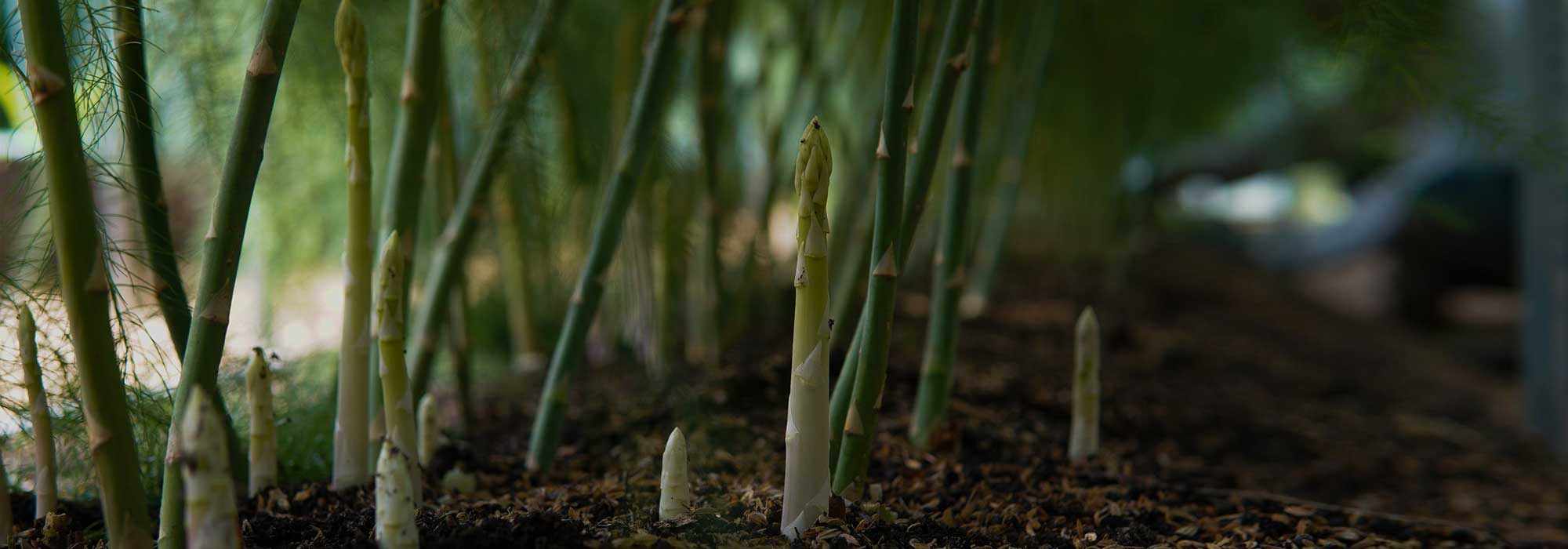
Asparagus: planting, growing, harvest
Contents
Asparagus in a nutshell
- Asparagus is a perennial herbaceous grown as a vegetable and medicinal plant
- The colour of asparagus (green, white, or purple) depends on its cultivation method
- The edible part of asparagus is called a turion
- Asparagus is grown in full sun or partial shade, in sandy, humus-bearing, well-drained soil
- It takes three years before the first harvests can be made
A word from our expert
Asparagus is a vegetable known since antiquity, consumed for its refined flavour for over 2,500 years. Wild asparagus can be found in Europe, Asia, and North Africa.
Although it is relatively easy to grow, asparagus is a vegetable that requires patience, as it takes three years of cultivation before it can be harvested and enjoyed. After these three years, the edible shoots can be collected using a dedicated tool. As a perennial plant, asparagus can then be harvested for 10 to 15 years.
It is important to note that the colour of asparagus is absolutely not related to the variety, but to the amount of light it receives during its cultivation. Indeed, green asparagus has simply benefited from enough light to promote normal photosynthesis. Purple asparagus takes on this colour when only the top of its stem emerges from the ground. Finally, only the heads of white asparagus are exposed, thanks to repeated earthing up of the stem.
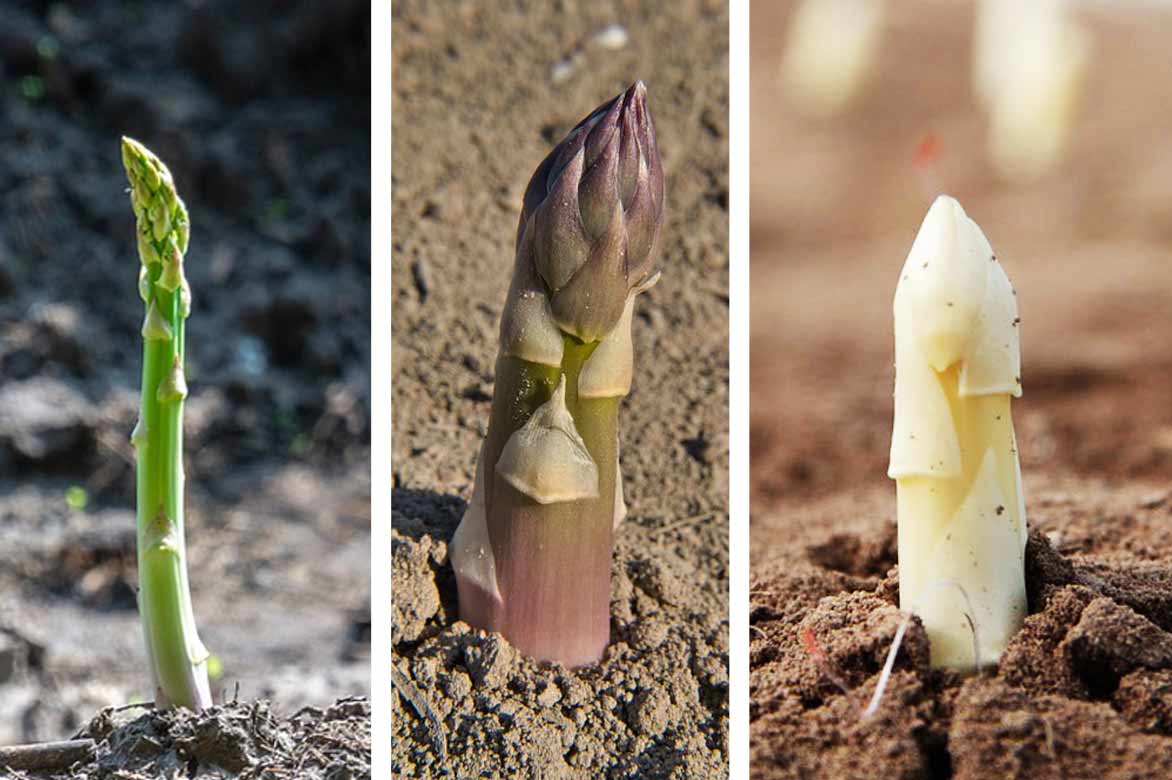
Asparagus is more sensitive to cold and humidity than anything else. It is grown in sunny or partially shaded locations, in sandy soil that is rich in humus, moist, but well-drained.
With a sweet and bitter flavour, asparagus can be enjoyed cooked in various dishes: cold with vinaigrette, in veloutés, gratins, etc.
Asparagus is a vegetable rich in vitamins A, B9, PP, as well as phosphorus and manganese. It is recognised for its diuretic, depurative, and laxative properties, classifying it among medicinal plants. Asparagus also contains asparagine and asparagus acid, which give a very specific odour to the urine of those who consume it.
Note: asparagus should not be consumed in excess, and it is not recommended for individuals suffering from certain illnesses.
Description and botany
Botanical data
- Latin name Asparagus officinalis
- Family Asparagaceae
- Common name Common asparagus, Edible asparagus, Asparagus, Spargel, Esparrago, Sparagio
- Flowering May to July
- Height 50 cm to 1.5 m
- Exposure sunny to partially shaded
- Soil type sandy, rich in humus, moist, well-drained
- Hardiness -15°C
Asparagus officinalis, commonly known as asparagus, is a herbaceous perennial plant from the family Asparagaceae (formerly Liliaceae), native to temperate Eurasia. The cultivated asparagus in our gardens was introduced to Italy by the Greeks, and then to France by the Romans, who were the first to cultivate and select it for the fine green stem with a bitter taste that we know today.
Asparagus is a rhizomatous perennial plant, mesoxerophilous1 and dioecious2, with a bushy, upright, climbing, or trailing habit. It has long, slender green and branching stems that are upright and cylindrical, with very spreading branches.
Its vigorous rhizomatous stump, called crown, consists of numerous fleshy roots arranged in a star shape. After 3 years, thick, glabrous shoots3 measuring between 50 cm and 1 to 1.5 m emerge from this root system. The terminal part of the shoot is consumed, which is therefore a bud with tightly packed scales.
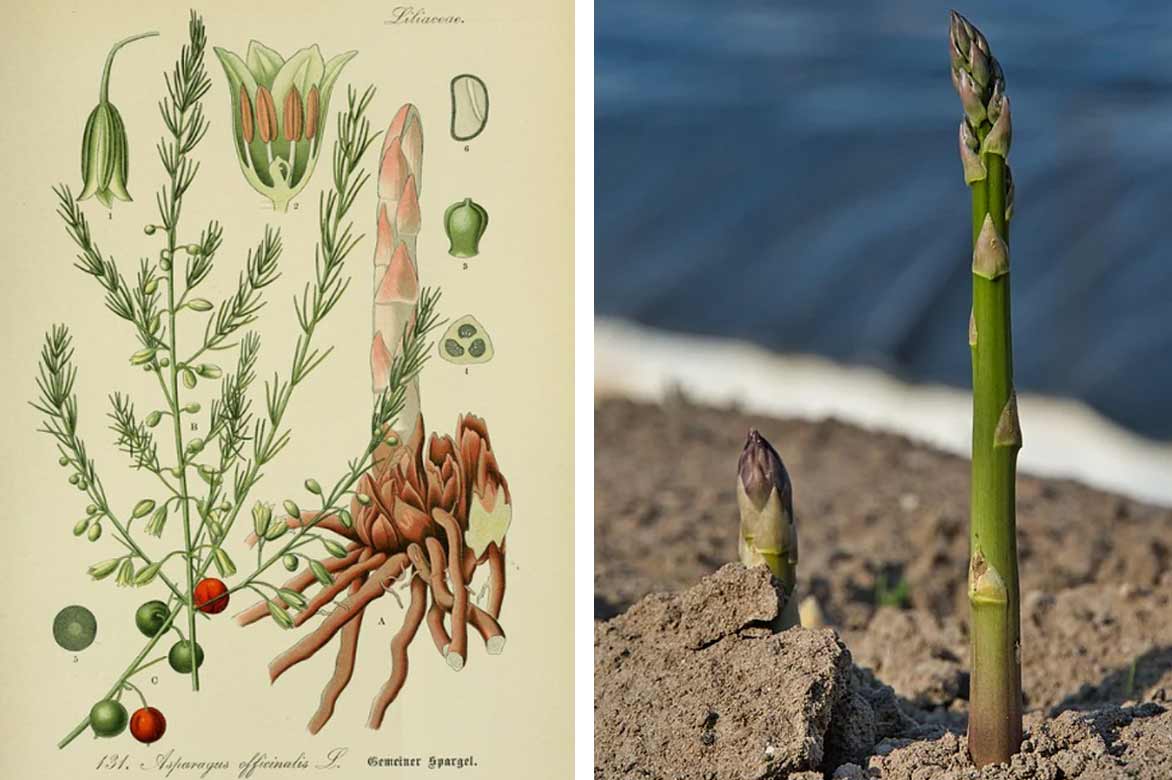
Asparagus does not have leaves, but has axillary4 thread-like and fasciculate cladodes, with a membranous scale at their base. A feathery and bushy “foliage” that disappears in winter, as it is deciduous.
Depending on the climate, the flowering of asparagus can occur from late spring to summer, between May and July. As a dioecious plant, male and female plants of asparagus produce tiny flowers, measuring between 4 and 6 mm, axillary, campanulate, and pendulous, with a yellowish-green colour, either solitary or geminate.
Fruiting takes the form of inedible globular berries the size of a pea, which can be green, red, or black. These fruits are highly appreciated by birds, which help in the dispersion of the triangular black seeds.
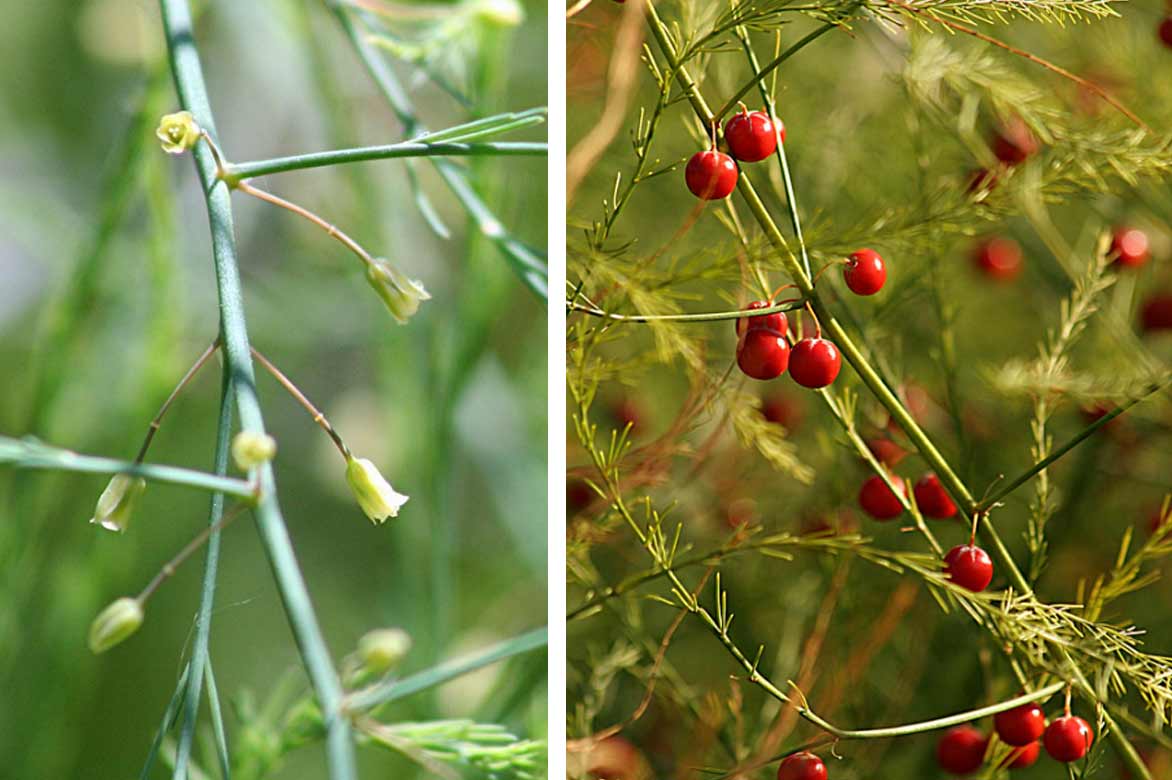
Asparagus officinalis, flowers and fruits © M. Martin Vicente – Flickr
1-Mesoxerophilous: relatively xerophilous, living in dry places.
2- Dioecious: each individual bears only one type of male or female gamete.
3- Shoot: refers to the young stems that arise from a perennial plant’s crown.
4-Cladode: a flattened branch that resembles a leaf.
Read also
What is an asparagus gouge used for?Main species and varieties
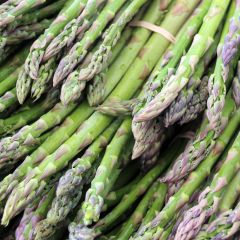
Lima Green asparagus crowns - Asparagus officinalis
- Height at maturity 1 m
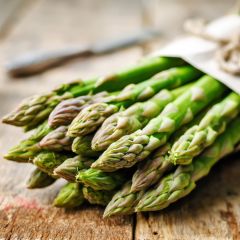
Voltaire Asparagus crowns - Asparagus officinalis
- Flowering time August
- Height at maturity 1,25 m
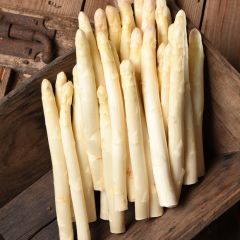
Argenteuil Asparagus - Asparagus officinalis
- Height at maturity 1 m

Emma Asparagus crowns - Asparagus officinalis
- Height at maturity 1 m
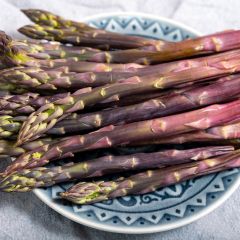
Rosalie Asparagus crowns - Asparagus officinalis
- Flowering time July, August
- Height at maturity 1,20 m
Discover other Asparagus plants
View all →Available in 1 sizes
Available in 1 sizes
Available in 1 sizes
Available in 1 sizes
Available in 1 sizes
Available in 1 sizes
Available in 1 sizes
Available in 1 sizes
Available in 1 sizes
Asparagus planting
Where to install asparagus?
Asparagus should be planted in a sunny or partially shaded location. Preferably choose a spot where no root vegetables have grown in previous years. Additionally, ensure the soil provides suitable growing conditions to guarantee the quality of your asparagus production. Opt for sandy or loamy-sandy soils, and absolutely avoid clay and wet soils.
Note: For asparagus cultivation, soil is considered clayey if it contains more than 8% clay.
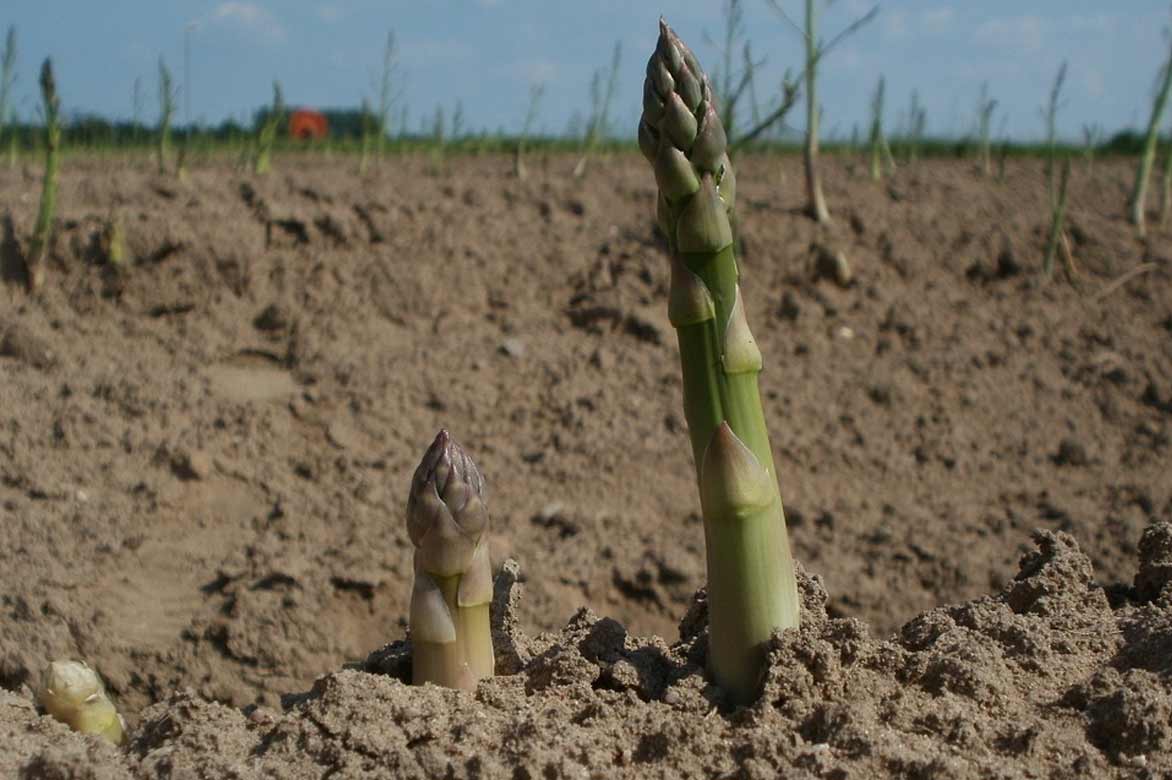
When to plant asparagus?
The planting of asparagus typically occurs between March and April, in soil that has been prepared the previous autumn. In the mildest climates of the region, planting can be advanced to February.
How to plant asparagus?
Asparagus crowns are installed directly in the ground in the vegetable garden, in well-prepared soil. Be careful, the crowns must not dry out. If you purchase them from a garden centre ready for planting, proceed with the planting immediately after acquisition.
Autumn soil preparation
- For green and purple asparagus cultivation, start by digging a trench 40 cm wide and 15 cm deep. If you are growing white asparagus, the trench should be 25 cm deep, with the same width. The trenches should be spaced 1.5 m apart.
- Loosen the bottom of the trench and add sandy soil and well-rotted compost by scratching.
Spring planting
- Form small mounds of soil 10 cm high and wide, spacing them 50 to 60 cm apart.
- Place the asparagus crowns so that they point upwards.
- Spread the roots over each mound.
- To mark their location, install a stake next to each crown and tie a string to it.
- Backfill the trench with the soil you reserved from the previous autumn. Each crown should be covered with 3 cm of soil.
- Water gently to avoid displacing the freshly planted crowns.
Read also
Succeeding in growing asparagusHarvest, storage, and use
Harvesting
The first harvest occurs after three years of cultivation, starting in April. Asparagus is then picked as soon as it emerges from the ground. To successfully carry out the harvest, make sure to have a asparagus gouge. This tool allows you to cut the shoot at its base without needing to dig up the soil or disturb the mound.
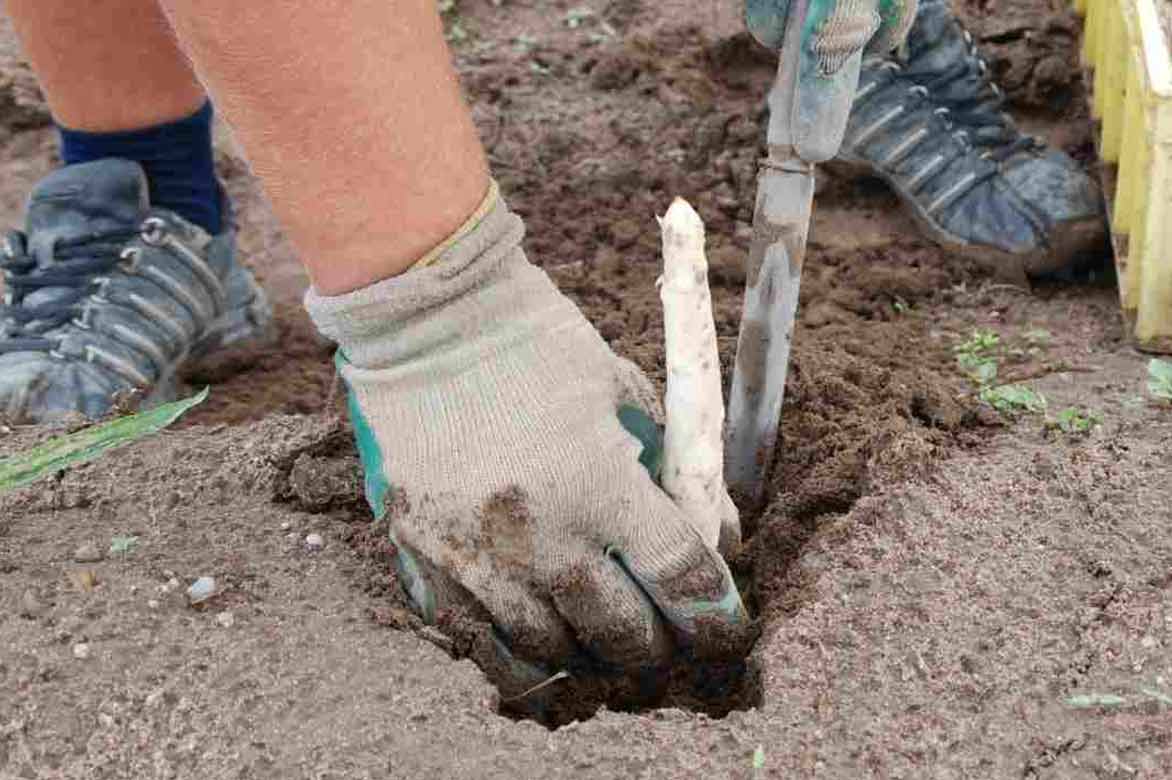
Note: during the first few years, be sure to harvest your asparagus sparingly. Proceed over two to four weeks, allowing the remaining asparagus to grow, ensuring to stake them as they develop.
Storage
Freshly harvested asparagus can be stored for a few days in the vegetable drawer of the refrigerator, provided it has been wrapped in a damp cloth. In any case, it is best to consume them quickly after harvest.
You can also store your asparagus in a cool place in dry sand, just like carrots.
Cooking uses
Asparagus has the great advantage of being tasty without being calorific. In fact, it contains few calories, about 20 per 100 g of cooked asparagus. However, the sauces it is often enjoyed with are much richer.
While small green asparagus do not require it, white and purple asparagus must be peeled with a peeler before preparation.
Regardless of their colour, they are cooked in boiling salted water, in an open pot or a large saucepan.
Good to know: asparagus can be canned or even frozen.
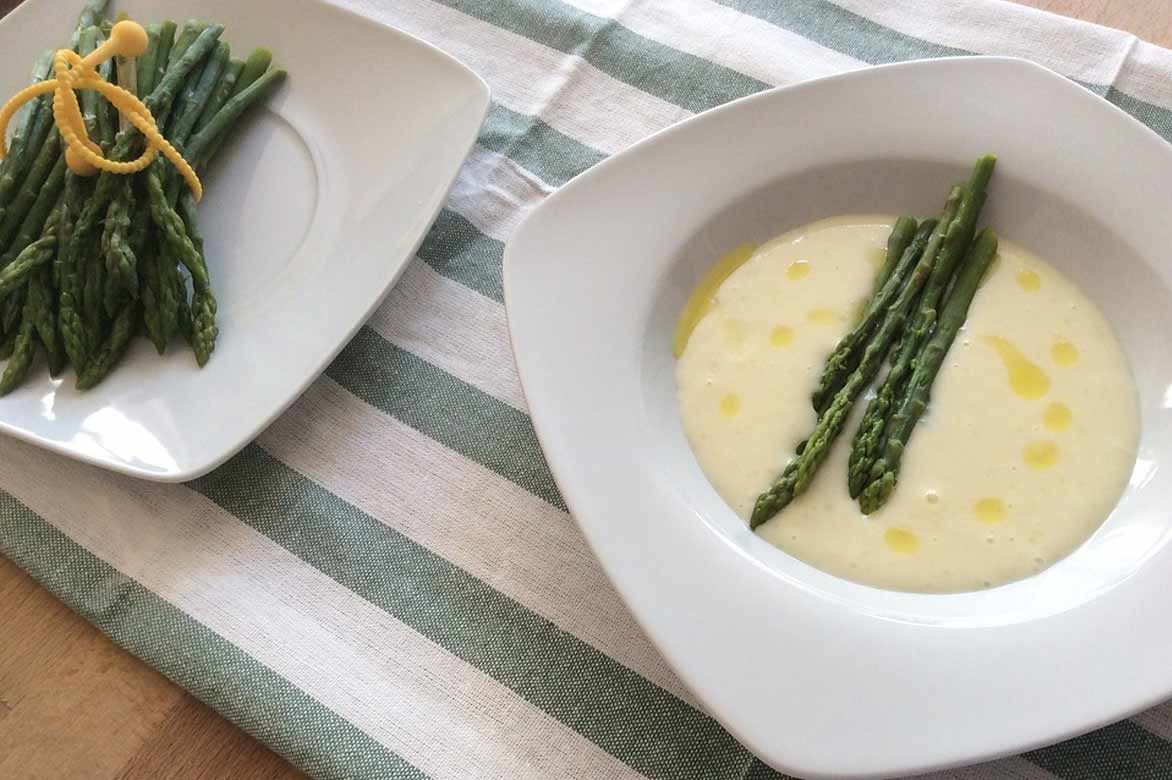
If they are most often enjoyed with a simple vinaigrette or a mousseline sauce, asparagus also lends itself to many delicious preparations, such as savoury tarts, veloutés, gratins, and more.
Virtues and benefits
Asparagus cultivated and harvested each spring is renowned for its richness in fibre, phenolic acids, flavonoids, and vitamins: A, C, B1, B2, B3, B6, B9, and K. It is also known for its richness in trace elements, such as calcium, iron, magnesium, potassium, and selenium.
In phytotherapy, the rhizomes and roots of asparagus are used for their diuretic properties. These properties are due to the presence of the amino acid asparagine, which is also responsible for the odour asparagus gives to urine.
Warning: medical use, as well as excessive consumption of asparagus, is strongly discouraged for individuals suffering from albuminuria, anuria, kidney stones, cystitis, gout, nephritis, prostatitis, or any diseases of the kidneys and bladder.
Asparagus care and maintenance
As we have seen, the first harvest occurs after three years of cultivation. This is a considerable period during which you will not remain inactive.
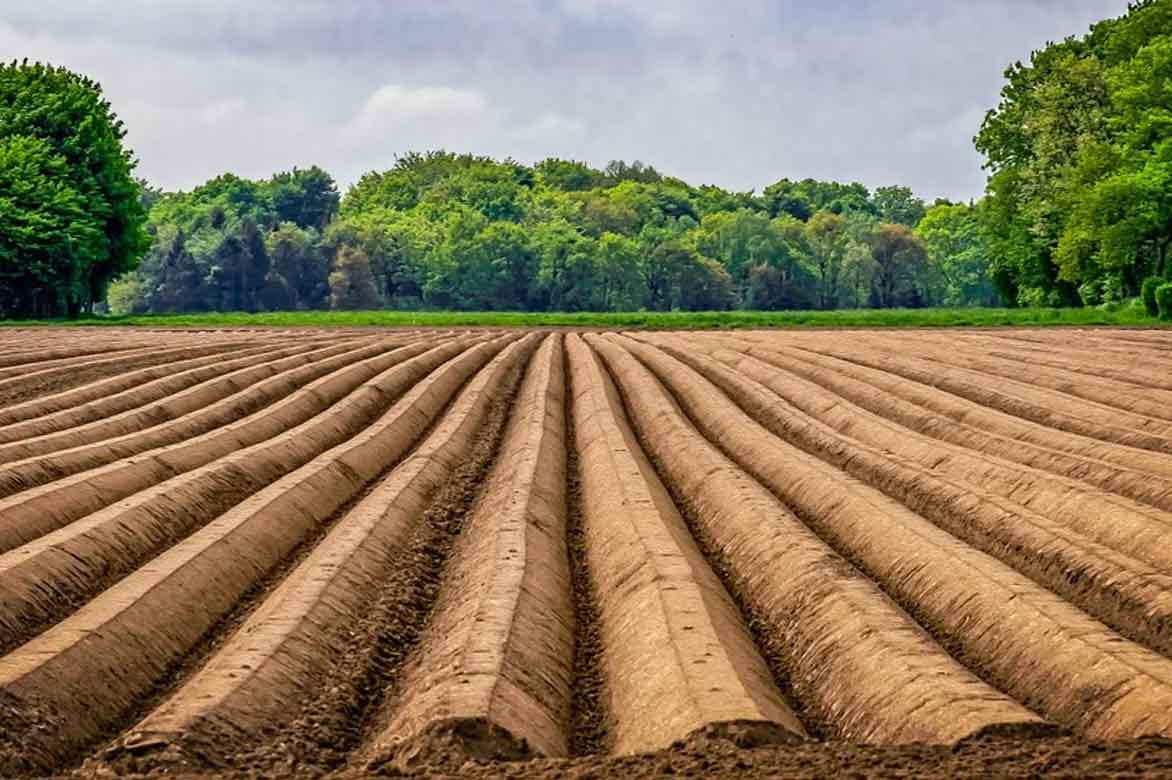
Asparagus growing during the first year
The first year of cultivation is when the asparagus crowns are planted. Regardless of their colour, they should be covered with 3 cm of soil. Once well established, their maintenance consists of regularly weeding the cultivation area. This chore can be greatly reduced by installing a layer of mulch, which is very effective in limiting the growth of adventive plants.
Asparagus growing during the second year
During this second year of cultivation, you must ensure that the asparagus crowns are continuously covered with 7 to 12 cm of soil if you are growing green and purple asparagus, or 20 cm of substrate if they are white asparagus.
For the rest, the shoots should be tied to their supports, or to the training wire, as they grow.
Asparagus growing during the third year
The first harvest occurs during this third year of cultivation.
If you are growing white asparagus, carry out successive earthing up from March. To do this, form mounds of soil 30 to 40 cm high around the shoots, repeating the process as they grow. These ridges should be removed once the season is over.
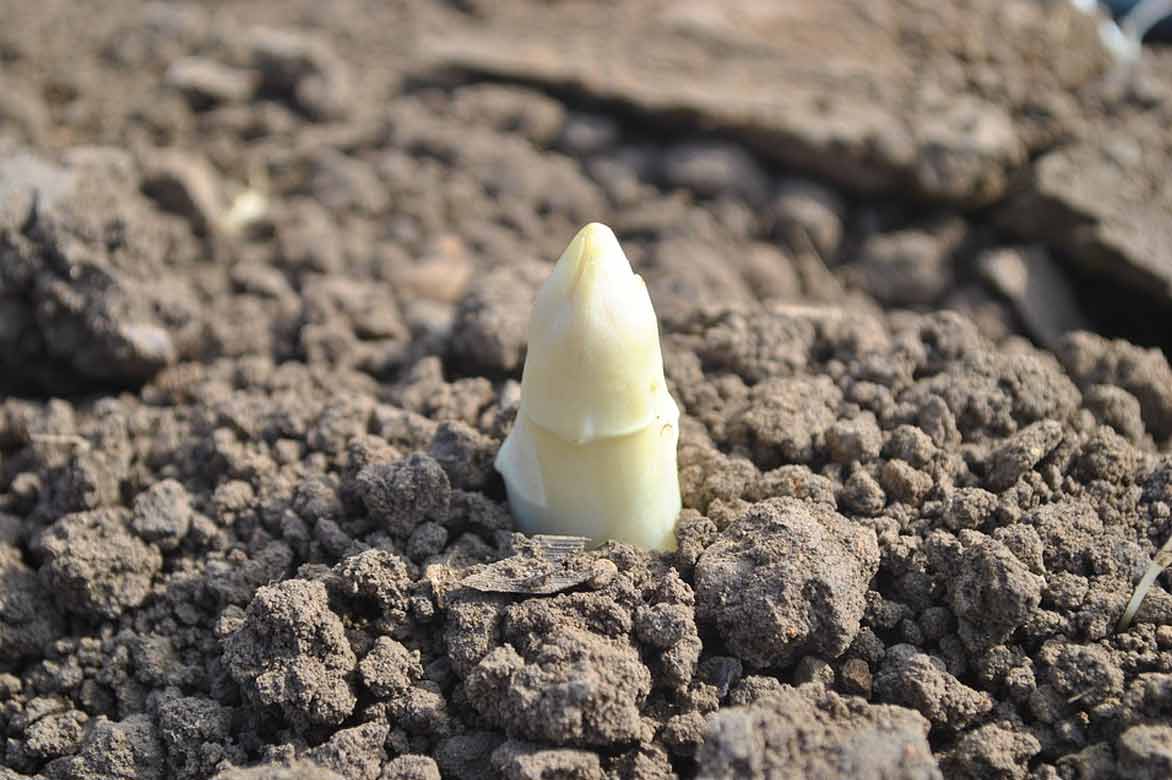
Annual maintenance
Asparagus can remain in place and produce shoots for 10 to 15 years. Each year, add compost to the cultivation soil at a rate of 1 kg per m2. Regardless of their colour, asparagus requires regular but moderate watering.
Diseases and potential pests of asparagus
Asparagus officinalis is a robust plant, not particularly prone to ailments, but it can still be affected by purple rhizoctonia, the most common disease of asparagus. This fungal disease persists in the soil and affects the base of the stems as well as the roots of the asparagus, which become covered with a purple felt before the stems yellow and dry out. To prevent this disease, plant your crowns in soil that has previously been used for leek cultivation.
The plant can also fall victim to the asparagus beetle. This beetle devours the leaves of the asparagus, significantly weakening the young plant. To get rid of them, handpick the insects before spraying a pyrethrum-based solution on your crops.
The asparagus fly is also one of the main pests of asparagus. The larvae deform and inhibit the growth of the spear by burrowing galleries in the stems. To avoid them, burn the dried foliage of your asparagus at the end of the season.
→ Learn more in our advice sheet: Diseases and pests of asparagus.
Multiplying asparagus
Sowing asparagus
Sowing asparagus is an operation reserved for the most experienced gardeners. Indeed, harvesting seeds is delicate and requires a non-hybrid variety and female asparagus plants, as they are the ones that produce the seeds. Not to mention that the results of sowing can be slow and often disappointing.
The operation takes place in a nursery, in spring, between the months of March and June.
- Dig furrows spaced 30 cm apart.
- Place one seed of asparagus every 10 cm.
- Water with a fine spray.
- Transplant the young asparagus crowns the following spring.
Dividing the rhizome or crown
Multiplying asparagus by division is a much easier operation than sowing. The division of asparagus plants takes place during the plant’s dormancy period, between March and April.
- Start from a mature plant.
- Dig up the crown and wash it thoroughly.
- Divide the rootstock into two or three pieces using a clean, sharp tool. Cut between the buds, ensuring roots are retained with each section.
- Replant immediately after division to prevent the roots from drying out.
- Water with a fine spray after planting.
- Provide moderate but regular watering until the first signs of recovery appear.
Pairing asparagus
To deter unwanted pests, install fragrant plants around the asparagus bed, such as tansy, tomato, or common rue.
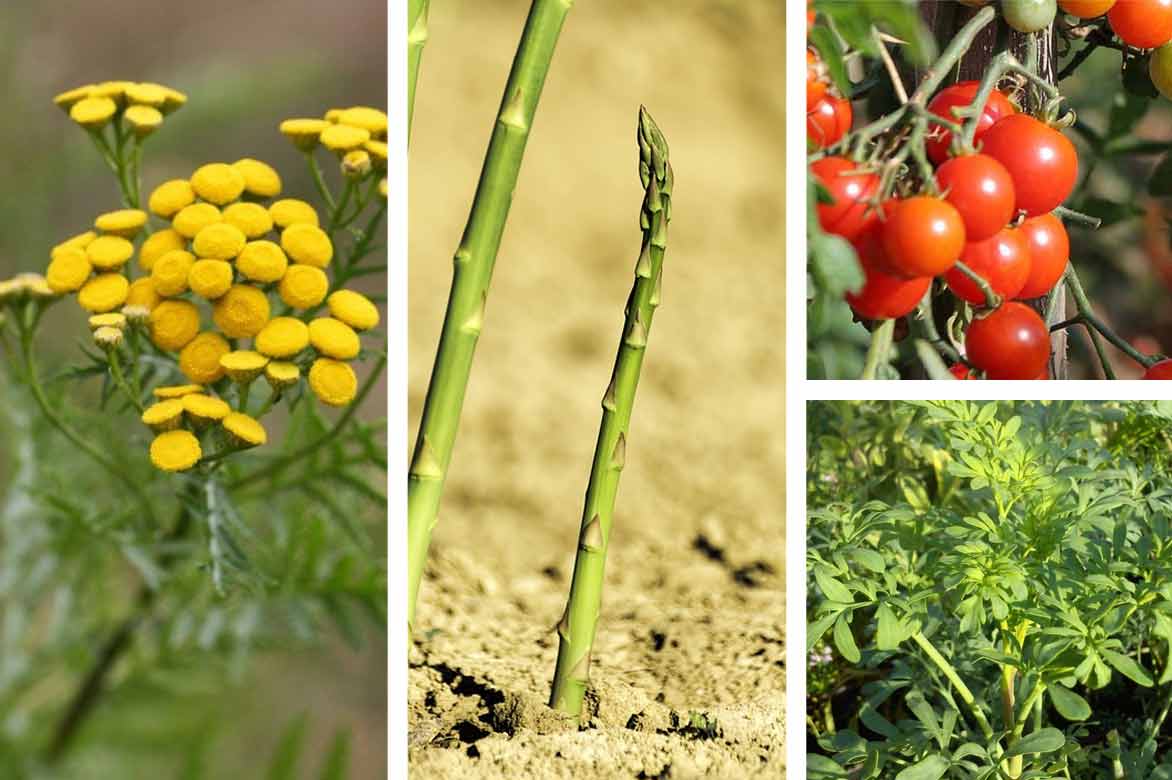
Useful resources
- Find all of Ingrid’s tips for growing asparagus in your vegetable garden.
- Discover what an asparagus gouge is used for, a gardening tool that allows you to harvest asparagus, but not just that!
- More asparagus planting tips can also be found on the Promesse de Fleurs blog.
- All our asparagus varieties in sheaths, pots, and crowns are available on the online shop.
- Subscribe!
- Contents
































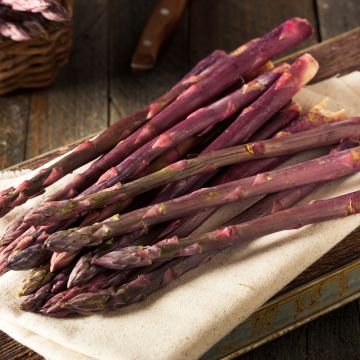

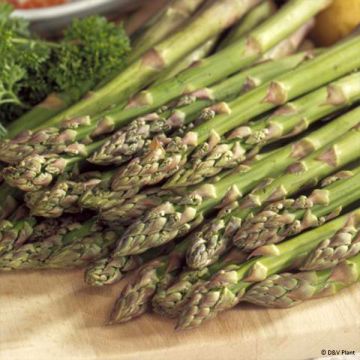
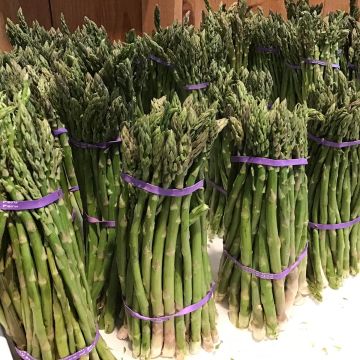



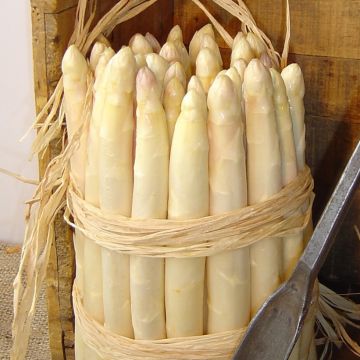
Comments